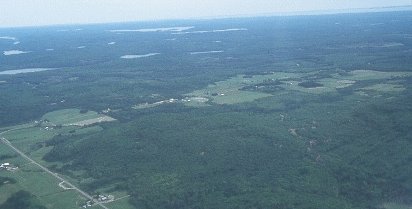|
Back to Settlements Introduction Farming Church School Hall Transportation Everyday Life |
An Overview of the History of Kynoch The rural community of Kynoch is situated about 15 miles north of Iron Bridge. It straddles the concession line of the townships of Grassett and Parkinson. A rural farming community, Kynoch was first settled in 1888. The construction of the Canadian Pacific Rail line of the Sudbury-Sault Ste Marie section brought the first interest in the area, in the form of two men, William Watson and Matthias Trivers, Sr. While exploring the area, they happened upon the valley. They worked in a lumber camp in Parkinson Township in the winter of 1885. In 1886 they began clearing land and building cabins on Lot 8 concession 1 in Grassett Township. They cleared a ten-acre strip on lots 7 and 8, and then reported back to work on the CPR. While they were away, fire destroyed all the work they had done. Their work with the railway being finished in 1887, they returned to the valley with Robert Dunn Sr., who cleared land in Parkinson township. They worked in the lumber camps in the winter and then rebuilt the cabins on their lots. They sent word in 1888 that their families were to come from Southern Ontario to homestead the farms.The journey north required taking a steamboat from Owen Sound to Thessalon. From there they went to Basswood Lake, which was crossed in a rowboat. They then portaged to the Mississagi River, also crossed by rowboat, and walked a bush trail to the homesteads. The only source of income for the families, at that time, was what the men earned in the lumber camps in the winter. In the summer they continued to clear land and plant the land they had already cleared. In 1891 the market for spruce pulpwood opened up, giving the settlers another source of income. Logs cleared from their land could be sold as pulp. In 1892, the community was stricken with a scarlet fever epidemic. Unlike today, there was limited, or no treatment for a variety of diseases. The mortality rate was high. At least two members of every family succumbed to the fever. A wooden bridge was built just above Bell's Falls in 1892, connecting the community to the road on the south side of the river. By 1895, better homes were being built and crops were starting to take hold. Land was still being cleared and horses were replacing oxen. Harvesting was done with scythe and grain cradle. Bellingham church had been built in 1897 at Bell's Falls. Sunday services are still held at the church to this day. Plans for building a school were developed in late 1905 and by 1907 residents had their own school. The school served the community until it was closed in 1967. The Kynoch post office opened in 1912, and closed in 1933. The Women's Institute canvassed for donations towards building the Kynoch hall in 1929, which is in use to this day. Telephone service reached the Algoma district by 1905. The Parkinson and Kynoch Telephone Company Limited brought the first telephones to the Kynoch area in 1929. The phone changed over to Bell Canada after 1954. By 1953 electricity had come to the valley, making a vast change in the way people lived. The Kynoch Wolf Cub Pack was formed in 1957 and ran to 1958. In the later years of this century there have been improvements on the road, now no longer a gravel road. The old bailey bridge was replaced by a concrete bridge in 1986. In essence the settlement remains much as it always was, a peaceful farming community. Return to Top |
Home | Natural Environment | History | Industry | Personalities/Stories | Credits/Team